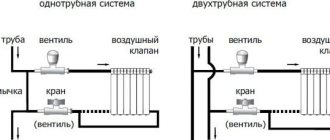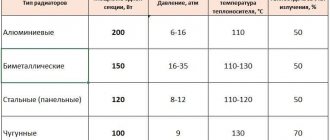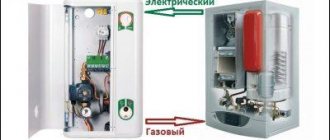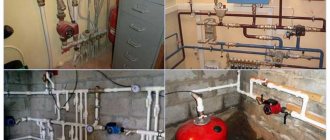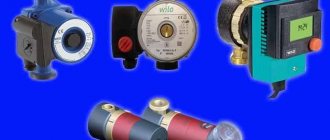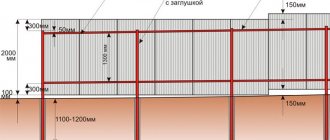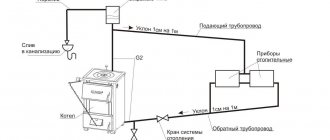How can you regulate the temperature of a heating battery?
In private houses and apartments, quite often a phenomenon occurs such as a difference in the level of heating of radiators connected to the heating system. Therefore, residents are forced to put up with uncomfortable living conditions, because the temperature in the bathroom can differ significantly from that in the bedroom or living room. This problem is especially typical for owners who use autonomous heating in houses and apartments.
Homeowners can avoid common problems with the heating system by properly installing a device such as a radiator regulator, which is designed to control the temperature of the radiator. Modern temperature controllers for radiators are available in a wide range of models and can be used by homeowners to optimize the heating system, reduce energy costs and maintain optimal temperature conditions in every room of the house.
Types of control valves
Existing modern heat supply technologies make it possible to install a special tap on each radiator that controls the quality of heat. This control valve is a shut-off valve heat exchanger, which is connected via pipes to the heating radiator.
According to the principle of their operation, these cranes are:
Ball ones, which primarily serve as 100% protection against emergency situations. These shut-off devices are a structure that can be rotated 90 degrees and can allow water to pass through or prevent the passage of coolant.
The ball valve must not be left in a half-open state, as in this case the sealing ring may be damaged and a leak may occur.
- Standard, where there is no temperature scale. They are represented by traditional budget valves. They do not provide absolute accuracy of adjustment. By partially blocking the access of coolant to the radiator, they change the temperature in the apartment to an indefinite value.
- With a thermal head that allows you to adjust and control the parameters of the heating system. Such thermostats are automatic and mechanical.
Conventional direct-acting thermostat
A direct-acting thermostat is a simple device for controlling the temperature in a heating radiator, which is installed near it. By its design, it is a sealed cylinder into which a siphon is inserted with a special liquid or gas that clearly reacts to changes in the temperature of the coolant.
As it increases, the liquid or gas expands. This leads to increased pressure on the rod in the thermostat valve. It, in turn, moving, blocks the flow of coolant. When the radiator cools, the reverse process occurs.
Thermostat with electronic sensor
This device is no different in operating principle from the previous version, the only difference is in the settings. If in a conventional thermostat they are performed manually, then an electronic sensor does not need this.
Here the temperature is set in advance, and the sensor monitors its maintenance within the specified limits. The electronic thermostatic sensor regulates the control parameters of the air temperature within the range from 6 to 26 degrees.
Automatic adjustment
Automatic maintenance of room temperature is good because once you set the control knob to the desired position, you will get rid of the need to twist and change something for a long time. The temperature of the heating radiators is adjusted constantly and continuously. The disadvantage of such systems is their significant cost, and the more functionality, the more expensive the device will be. There are some other features and subtleties, but more on them below.
Adjusting radiators with thermostats
To maintain a constant set temperature in a room (room), thermostats or thermostats for heating radiators are used. Sometimes this device may be called a “thermostatic valve”, “thermostatic valve”, etc. There are many names, but one device is meant. To make it clearer, it is necessary to explain that the thermal valve and thermal valve are the lower part of the device, and the thermal head and thermoelement are the upper part. And the entire device is a radiator thermostat or thermostat.
This is what the thermostat on the radiator looks like
Most of these devices do not require any power source. The exception is models with a digital screen: batteries are inserted into the thermostatic head. But their replacement period is quite long, the current consumption is low.
Structurally, the radiator thermostat consists of two parts:
- thermostatic valve (sometimes called “housing”, “thermal valve”, “thermal valve”);
- thermostatic head (also called “thermostatic element”, “thermoelement”, “thermal head”).
The valve itself (body) is made of metal, usually brass or bronze. Its design is similar to that of a manual valve. Most companies make the lower part of the radiator thermostat unified. That is, heads of any type and any manufacturer can be installed on one body. Let us clarify: you can install a manual, mechanical, or automatic thermocouple on one thermal valve. It is very comfortable. If you want to change the adjustment method, you do not need to buy the entire device. They installed another thermostatic element and that was it.
The difference between a manual radiator regulator and an automatic one is only in the installed thermal head
In automatic regulators, the principle of influencing the shut-off valve is different. In a manual regulator, its position is changed by turning the handle; in automatic models there is usually a bellows that presses on the spring-loaded mechanism. In electronic devices, everything is controlled by the processor.
The bellows is the main part of the thermal head (thermoelement). It is a small sealed cylinder containing liquid or gas. Both liquid and gas have one thing in common: their volume is highly dependent on temperature. When heated, they significantly increase their volume, stretching the bellows cylinder. It puts pressure on the spring, blocking the flow of coolant more strongly. As it cools, the volume of gas/liquid decreases, the spring rises, the coolant flow increases, and heating occurs again. This mechanism, depending on the calibration, allows you to maintain the set temperature with an accuracy of 1oC.
Watch the video to see how the thermostat works.
The radiator thermostat can be:
- with manual temperature control;
- with automatic; with built-in temperature sensor;
- with remote (wired).
Using Three-Way Valves
A three-way valve is rarely used to regulate battery temperature. He has a slightly different task. But in principle, it is possible.
By installing a three-way valve on the supply side, you can also regulate the coolant temperature
A three-way valve is installed at the junction of the bypass and the supply pipe going to the radiator. To stabilize the temperature of the coolant, it must be equipped with a thermostatic head (of the type described above). If the temperature near the head of the three-way valve rises above the set value, the flow of coolant to the radiator is blocked. It all rushes through the bypass. After cooling, the valve operates in the opposite direction and the radiator heats up again. This connection method is implemented for single-pipe systems, more often with vertical wiring.
We set up the heating system of a country house ourselves
In my previous article, I wrote that one of the effective ways to modernize heating systems in private buildings is to switch from an open heating system to a closed one. The heating system of a residential building improved in this way has many advantages, which together ensure its simple operation; you just need to turn on the boiler at the beginning of the heating season and turn it off at the end. All!
However, in order for the heating system of a country house to work in this mode (turned on, “forgot” for six months, turned off), you need to correctly configure and adjust its operating parameters. This is what my article will discuss. I will make the main calculations, conclusions and calculations using the example of my heating system, but the reader can always use this information by drawing an analogy with his own specific case.
How to properly regulate radiators
Automatic thermostats are highly practical in residential heating systems and successfully replace shut-off valves. Despite the fact that conventional taps are a cheap option, heating control using special elements is safer and more convenient. When using shut-off valves, air pockets or stoppages of water flow may form in the system. The regulator works in such a way that the water flow is reduced, but not completely blocked, so emergency situations are eliminated. Using taps takes extra time, but with an automatic regulator it is enough to set the required temperature.
So, the advantages of automatic valves have been established, and now we can talk about how to regulate radiators. Thermostats or thermostatic valves do an excellent job of providing efficient heat transfer depending on the temperature conditions outside.
A standard automatic thermostat is equipped with a thermal head that responds to even slight changes in temperature. The regulator bellows contains a special compound that, when heated, changes its state and expands. This provides an impact on the valve, after which the coolant flow decreases.
Control valves for radiators
To manually regulate the operation of heating devices, special valves are used. Such taps are sold with straight or angular connections. The procedure for regulating heating batteries using these devices manually is as follows.
When the valve is turned, the shut-off cone lowers or rises. In the closed position, the coolant flow is completely blocked. Moving up or down, the cone regulates to a greater or lesser extent the amount of circulating water.
Due to this operating principle, such valves are also called “mechanical temperature controllers”. They are installed on batteries with threads, and connected to pipes with fittings, most often of the crimp type.
The control valve used for heating devices has the following advantages:
- the device is reliable, it is not dangerous from blockages and fine abrasive particles present in the coolant - this applies exclusively to high-quality products in which the valve cone is made of metal and carefully processed;
- the product has an affordable price.
Control valves also have disadvantages - each time you use the device, its position has to be changed manually and for this reason it is quite problematic to maintain a stable temperature regime.
For those who are not satisfied with this procedure and are thinking about how to regulate the temperature of the radiator using another method, the use of automatic products that allow them to control the degree of heating of the radiators is more suitable.
Recommendations for installing devices
As a rule, a thermostat on a heating battery is mounted at the inlet of the radiator in accordance with the heating circuit developed earlier, however, some homeowners install devices at the outlet, trying to reduce the influence of the outflow of cooled liquid on the operation of the regulator.
The installation process itself is quite simple and does not require any special practical skills. The work of installing regulators is not much different from the process of installing any connecting fittings used in a heating system, therefore, if you have basic equipment and basic skills in handling them, installation of regulators can be done quite quickly.
Thus, by using affordable and functional regulators in the heating system, you can achieve significant results in terms of energy savings and achieve smooth distribution of heat from heating devices in a house or apartment.
Device and purpose
If a water temperature regulator is installed in the heating system, it adapts to the created need the rate of passage of coolant into the radiator. By installing such a device together with a heat meter, you can save money and reduce wasteful energy consumption. Depending on the needs and capabilities of residents, it is worth buying models with manual temperature programming for the day and night, or with pre-planned microclimate parameters for specific days. These functions can be combined with each other. Then it will be possible to both eliminate unnecessary heating during warm hours and quickly prepare for the approaching frosts or thaws.
The differences are expressed largely in the specific way in which the temperature sensor is implemented and what its basic operating principle is. Some models measure the air temperature in rooms, while others focus on heating the water in the main. This does not affect the accuracy of measurement and adjustment to real needs. The main thing is that all the nuances and subtleties are taken into account. In most cases, too precise equipment is not needed, since it only burdens the personal budget.
Each room can be equipped with its own thermostat; it is even possible to use devices of different brands and models. The signal to the control relay can come from a sensor that measures the temperature of the coolant in the radiators. But such a scheme is considered outdated and does not meet the latest technical requirements. The thermostat is fundamentally incompatible with cast iron batteries. Only if radiators of a more modern design are installed in the room is it allowed to use it.
You need to understand that thermostats are not some kind of “magic” solution; with their help, it is impossible to extract more energy from the heating system than it is capable of supplying. But they are quite capable of reducing heat consumption or increasing it to the maximum as needed. A typical design includes not only a valve and a unit that receives signals from the control panel. The thermal valve and thermal head are very important elements. The selection of parts is made according to the size of the pipeline and the type of heating system.
In addition to the components already mentioned, the thermostat may include:
- collapsible connection;
- spool;
- compensating block;
- throw-on nut;
- fastening ring;
- scale on which the temperature is adjusted.
Types of heating systems and the principle of adjusting radiators
Handle with valve
In order to correctly adjust the temperature of radiators, you need to know the general structure of the heating system and the layout of the coolant pipes.
In the case of individual heating, adjustment is easier when:
- The system is powered by a powerful boiler.
- Each battery is equipped with a three-way valve.
- Forced pumping of coolant has been installed.
At the stage of installation of individual heating, it is necessary to take into account the minimum number of bends in the system. This is necessary in order to reduce heat loss and not reduce the pressure of the coolant supplied to the radiators.
For uniform heating and rational use of heat, a valve is mounted on each battery. With it, you can reduce the water supply or disconnect it from the general heating system in an unused room.
- In the central heating system of multi-storey buildings, equipped with a vertical supply of coolant through a pipeline from top to bottom, it is impossible to adjust the radiators. In this situation, the upper floors open the windows due to the heat, and the rooms on the lower floors are cold, since the radiators there are barely warm.
- A more advanced one-pipe network. Here, the coolant is supplied to each battery and then returned to the central riser. Therefore, there is no noticeable temperature difference in the apartments on the upper and lower floors of these buildings. In this case, the supply pipe of each radiator is equipped with a control valve.
- A two-pipe system, where two risers are mounted, ensures the supply of coolant to the heating radiator and back. To increase or decrease the coolant flow, each battery is equipped with a separate valve with a manual or automatic thermostat.
Thermostat for a heating radiator: operating principle and installation
When the cold weather arrives, the heating season begins. Heating radiators provide a comfortable microclimate in residential areas. Very often situations arise when the batteries are not configured correctly. They raise the temperature in the rooms too much. To escape the heat, stuffiness and dry air, people open their vents, windows and balconies. To create optimal temperature conditions in the apartment, you should install and configure a thermostat for the heating radiator.
Why do you need a thermostat?
A thermostat (also called a thermostat) is a device that is attached to a radiator and allows you to regulate the air temperature in the room. Some thermostat models are programmed to maintain different temperatures on different days, at different times of day.
Thermostat for heating radiator
The thermostat not only creates a comfortable environment for the inhabitants of the home, but also allows you to save on heating. To save money, a heat meter should be installed in apartment buildings. In private homes, the cost of purchasing and installing a thermostat is recouped in one heating season.
The thermostat is easily mounted on a radiator, does not require any costs during operation, maintains a wide temperature range (from +5 to +27 degrees Celsius), looks stylish in appearance and works accurately.
There is no need for preventive maintenance or maintenance while the thermostat is operating.
Thermostats are used not only in rooms of apartments and houses, but also in non-residential premises. In boiler rooms, a thermostat is used to protect equipment from overheating and high loads. It is installed at the outlet of the boiler (or boiler). The thermostat will prevent an accident in the heating system by controlling the increase in temperature and water pressure. It serves as a guarantee of safety against fires and explosions of gas boilers.
Thermostat at the outlet of the boiler (or boiler).
Using thermostats, you can control the temperature in production workshops, warehouses, cars (for example, Bugatti). They are even used in refrigerators. For this purpose, non-freezing devices are purchased.
Thermostats, designed to operate in extreme conditions, for non-residential premises, are capable of maintaining temperature conditions in the range from -20 to +70 degrees Celsius.
Another advantage of the thermostat is durability. The manufacturer provides a 1-year warranty for each device.
Note! Using a thermostat, you can only reduce the maximum possible temperature, but not increase it.
Direct thermostat
On your home thermostat, you can set the temperature from 5 to 30 degrees Celsius in 1-degree increments.
Types of thermostats
Depending on the method of connecting pipes to the radiator, thermostats can be straight or angular.
Corner thermostat
Thermostats are made from materials that are resistant to corrosion. They are usually made from:
- brass (sometimes with additional nickel plating);
- bronze (nickel-plated or chrome-plated);
- stainless steel;
The latter material is the most durable, but devices made from it are more expensive and are rare.
Stainless steel thermostat
Thermostats are also distinguished by the type of connection. There are products with union and crimp nuts.
Based on the type of working substance filling the head, thermostats are divided into:
- Liquid.
- Gas.
Liquid thermostats are easier to manufacture than gas thermostats, so their range is much wider than that of gas devices.
Thermostat for heating liquid
According to the principle of operation, the thermostat can be manual, mechanical and automatic (electronic).
Automatic (electronic) thermostat for heating
The simplest manual thermostat is a cone valve (pictured). The principle of its operation: a person turns the handle, and a conical rod blocks part of the liquid flow. The disadvantages of such a device are the lack of markings on the tap. You will have to independently determine at what position of the valve in the room the optimal temperature is established. Purchasing a manual thermostat for a heating radiator is the cheapest option.
Manual thermostat - cone valve
Often a mechanical thermostat valve is installed on the heating radiator. It has a special scale with printed numbers on which you can set the required temperature level (you can see in the photo).
Mechanical thermostat
The advantages of a mechanical device include low price, ease of installation and use.
Disadvantages of a mechanical thermostat:
- lower efficiency compared to an automatic device;
- the need for constant temperature adjustment when climatic conditions change;
- rapid failure of the protective cap (with regular closing and opening of the valve);
The operating principle of a thermostat for a heating radiator
The thermostat consists of a thermostatic valve and a thermal head.
Thermostat device
When you turn the handle of a mechanical device, the valve stem begins to move. The bore diameter of the seat decreases, its value corresponds to a comfortable temperature.
The thermostat has a simple operating principle. When hot water enters the radiator, the working substance (gas or liquid) is heated in the thermostat. Expanding, the substance increases the size of the cylinder (bellows) and puts pressure on the piston, which moves the cone. The cone goes down and blocks access to the radiator to the flow of hot water. The ambient temperature drops, the liquid (gas) in the thermal head cools and contracts, the cylinder decreases in size, and due to the spring, the cone rises and again opens full access to the coolant flow.
Electronic thermostats are the largest in size, but also the most functional. Unlike mechanical thermostats, electronic thermostats have a display with buttons (pictured). Typically, it is on such thermostats that you can set different temperature settings by day of the week or by time of day. For example, you can reduce the heating temperature to a minimum or turn it off at a time of day when everyone is at work and no one is at home.
Electronic thermostat for heating
Electronic thermostats operate on two batteries.
The price of a thermostat depends on its type, accuracy of operation, design and supported temperature range.
Attention! The thermostat should be mounted on a horizontal pipe, and the handle with the sensor should “look” towards the room. If placed vertically, warm air rising from the hot pipe will interfere with the sensor and it will not correctly detect the room temperature. An example of a successful location of a thermostat for a heating radiator is shown in the photo.
Correct location of the thermostat for the radiator
If horizontal installation is not possible, then it is worth purchasing a thermostat for a heating radiator with a remote sensor and placing it at some distance from the hot pipe.
Electronic thermostat with remote sensor
For the thermostat, you can purchase a special casing that prevents unauthorized unqualified persons from interfering with its operation. This is relevant in apartments where small children live, as well as in institutions where children spend a lot of time (kindergartens, schools).
Gas thermostats
The advantages of gas devices include:
- smooth temperature control;
- the thermostat determines the temperature in the room, it is not affected in any way by the heating of the coolant, since the gas is concentrated in the cold part of the sensor, far from the control valve;
- sensitive instant response to microclimate changes.
Thermostat for heating manufactured by Danfoss
The leader in sales of gas thermostats for heating radiators is Danfoss, a famous company from Denmark. The equipment they produce is famous for its reliability and durability. The service life of Danfoss devices is over 20 years.
Do-it-yourself thermostat installation
You can install the thermostat yourself. Regardless of the type of heating radiator, installation is carried out in the same way. The only thing worth considering is the type of heating system - single-pipe or two-pipe. Installing the regulator on a one-pipe system differs in that between the direct and return connections it is necessary to install a jumper pipe, which is called a bypass.
Installation diagram
Installation steps:
- First you need to turn off the supply of hot liquid, and then pour the water out of the heating device.
- You should cut off horizontal sections of pipes at some distance from the battery and disconnect them.
- The shut-off valve is dismantled if it was installed on the pipes and not on the radiator.
- If the installation takes place on a heating system with one pipe, then a jumper must be welded.
- The shanks are removed from the thermostatic and shut-off valves, which are then wrapped into battery plugs.
- At this stage, the harness is assembled and installed in the chosen location.
- Horizontal pipes coming from the riser are connected to the installed piping.
Rules for installing thermostats.
If you don’t have confidence in your own abilities, then you should entrust the installation of the thermostat to professionals. They will correctly connect the equipment in accordance with the developer’s recommendations.
Rules for installing a thermostat
There is no point in installing thermal heads on all radiators in the room. Heating devices whose power is 50% or more of the power of all batteries in the room must be regulated. That is, if there are two radiators installed in a room, the thermostat is installed only on the one that is more powerful.
Thermostats are suitable for all types of batteries (aluminium, steel or both metals), except cast iron. Cast iron radiators take a long time to heat up and retain and emit heat for a long time after the coolant is turned off. Thermostats on radiators of this type will not be effective. Installing temperature control equipment on a cast iron battery is a waste of money and time.
Attention! If the thermostat is installed on a radiator covered by furniture, curtains, a decorative box or screen, it will not adequately assess the temperature in the room. In such situations, you can install a thermostat with a remote sensor. The distance range can be 2 – 8 meters.
Thermostat with remote sensor
In addition to decorative ceilings, drafts, sunlight and various nearby electrical appliances (refrigerator, heater) can affect the adequate operation of the sensor.
It is recommended to install thermostats primarily in those rooms where temperature changes are the greatest. Such rooms include the kitchen (the temperature rises due to steam from cooking, the gas stove or oven being turned on), the living room (where many people gather), rooms in which the temperature rises due to direct sunlight.
Setting the thermostat. Recommendations from professionals
In order for the thermostat to function for a long time and correctly, adjustments are carried out immediately after its installation.
Thermostat setting steps:
- Close the doors and windows in the room, set the thermometer at the desired level.
- Turn the thermostat knob to the left all the way, thereby allowing full access to hot water.
- Wait until the temperature rises by 5-6 degrees Celsius.
- Turn the valve all the way in the opposite direction (to the right). The room will gradually become cooler.
- As soon as the temperature reaches the optimal level, the valve is smoothly turned to the left. When the battery makes noise and its body becomes warm, then you can stop rotating, since this is the position of the thermal head that will provide a comfortable level of heating.
The thermostat setting procedure allows you to calibrate the device. It is the same for almost all devices. Calibration of some thermostats takes place according to a different scheme, which can be found in detail in the device passport.
Thus, heating radiators with a temperature controller are practical and economical, especially for private homes. Thermostats are easy to install, do not require additional maintenance costs, create a comfortable indoor microclimate and save money spent on heating.
Pipe layout diagrams
Single-pipe and two-pipe wiring is typical for private houses. What is their difference?
Single-pipe wiring
It is the most economical option. Thanks to the diagram, you should get the following:
- A pipe runs along the bottom of the floor from the heating boiler, passing through the entire room and returning back to the boiler.
- Radiators are installed on top of the pipe, and the connection is made through the lower pipes. At the same time, hot water flows from the pipe into the heating device, which completely fills it. The part of the coolant that has given up heat begins to fall down and exits through the second pipe, again entering the pipe.
As a result, there is a step-by-step connection of radiators with the bottom connection of batteries
In this case, it is worth paying attention to one negative point that affects the efficiency of heat transfer. As a result of such a sequential connection of single-pipe wiring, a gradual decrease in the temperature of the coolant occurs in each subsequent heating element
Because of this, the last room will be the coldest.
This problem can be solved in two ways:
- a circulation pump is connected to the system, which evenly distributes hot water to all heating devices;
- in the last room you can increase the radiators, as a result the heat output area will increase.
This scheme has the following advantages:
- ease of connection;
- high hydrodynamic stability;
- low costs for equipment and materials;
- You can use different types of coolant.
Two-pipe wiring
For a private home, this heating scheme is considered the most effective. However, it is worth considering the fact that the costs will be considerable at first, because you will need to install two pipes to supply and remove hot water. But still, such a scheme has certain advantages over a single-pipe one:
- the coolant is evenly distributed throughout the room;
- you can control and regulate a certain temperature mode in each room;
- repair of any element of the heating system is possible without turning it off;
- very little fuel is consumed.
Settings
Pre-configuration is necessary for thermostats with bellows: models with remote sensors and electronic control do not need to be configured.
You can set the thermostat as follows:
- Minimize the influence of extraneous factors: turn off all devices in the room, close doors and windows.
- Place a control thermometer in a convenient place.
- Completely unscrew the thermostat valve by turning its head counterclockwise until it stops.
- Wait until the room temperature rises 1–2 ˚C above the desired value.
- Close the valve completely by turning the crown clockwise.
- When the desired temperature in the room is reached, open the thermostat little by little until it starts to heat up. At this moment, the sound of water should be heard from the radiator. At this point, the pre-tuning is considered complete.
USEFUL INFORMATION: Flushing radiators: methods and techniques
Step-by-step instructions for adjusting temperature
To ensure comfortable living conditions in the room, you need to perform some basic steps.
- Initially, it is necessary to bleed the air on each battery until water flows from the tap in a trickle.
- Then you need to adjust the pressure in the batteries.
- To do this, in the first battery from the boiler you need to open the valve by two turns, on the second - by three, and then according to the same scheme, increasing the number of turns of the valve being opened on each radiator. Thus, the coolant pressure will be evenly distributed over all radiators. This will ensure its normal passage through the pipes and better heating of the batteries.
- In a forced heating system, control valves will help to pump the coolant and control rational heat consumption.
- In a flow-through system, the temperature is well regulated by thermostats built into each battery.
- In a two-pipe heating system, you can control not only the temperature of the coolant, but also its quantity in the batteries using both manual and automatic control systems.
Types of cranes
Conventionally, the reinforcement can be divided as follows:
- semi-rotary ball valve;
- balancing valve;
- thermostatic valve;
- flush tap;
- Mayevsky's bleeding valve.
Cranes differ in price, design and application features, which determine where and for what purpose the device is installed.
There are valves with manual and automatic adjustment methods; here the difference is also noticeable in the price of the valve. A system with automatic temperature control works like this: the controller receives a signal from a temperature sensor and sends a command to the servos, as a result of which the size of the flow hole in the tap is adjusted depending on the set mode.
Ball valve
The name of the tap is due to the spherical shape of the valve, which has a through hole. The valve is designed for only two positions - open or closed; it is not intended for quarter-turn operation. When you turn the handle of the faucet, the valve also rotates, and the hole in it is located either parallel or perpendicular to the pipeline.
The body of the device is made of steel, brass, bronze or silumin. Steel is the leader in terms of strength, but it is susceptible to corrosion, so products made of bronze and brass are preferable as they are more durable.
A good choice would be a brass half-turn with thick walls and an American - this is the name of the union nut, which allows you to connect pipes and the radiator without rotating them and quickly.
Balancing valve
The difference between a balancing valve and a ball valve is the ability to smoothly adjust the position of the valve by several turns of the knob. To prevent the valve settings from being lost or someone accidentally knocking them down, it can be fixed in its current position. It is placed on the outlet pipe of the battery, and makes it possible to smoothly regulate the flow of coolant.
Valve with thermostat
The most expensive, but also the highest quality, are thermostatic valves. The thermal head is adjusted to a certain room temperature and affects the valve stem.
Under its influence, the valve increases or decreases the cross-section of the hole for the passage of coolant, thereby regulating the temperature of the radiator. A valve with a thermal head is installed on the inlet pipe, and a balancing valve is placed on the outlet pipe.
Flushing tap
As the name suggests, it is designed to drain water or other coolant from the radiator in order to flush it. It consists of a metal body and a long rod, equipped with a rubber gasket. Opens with pliers or a wrench. The disadvantage of the design is the rapid wear of the rubber gasket and the need to replace it.
Mayevsky's air crane
Modern radiators provide for the installation of Mayevsky taps; some models are supplied with already built-in valves. The Mayevsky valve is mounted at the top of the battery, since compressed air accumulates at the top.
The valve is usually activated by a flat screwdriver or wrench. The air is released until the hissing stops and water begins to ooze from the tap.
Connection features
Methods for connecting radiators
When installing heating systems in private homes, the following connection methods are used:
In this case, the supply pipe is connected from above, and the return pipe is connected from below to the same section. This connection diagram for the heating battery allows the radiator to heat up evenly. However, if the accordion has a large number of sections, then significant heat loss will occur, so it is better to use other connection options.
Saddle and bottom
This method is an excellent option for cases where pipes run through the floor. The connection is made to the pipes located at the bottom of the structure, in opposite sections. The only disadvantage of this method is its low efficiency, since heat loss can reach 15 percent.
Used when connecting devices with a large number of sections. As you might guess, the inlet pipe in this case is connected from above, and the outlet pipe from below, in the opposite section. This scheme for connecting heating radiators in a private house promotes uniform distribution of coolant and maximum heat transfer from appliances.
Note! When using a thermostat for heating parallel to the radiator, a bypass must be installed. This will allow you to regulate the degree of heating of the device.
Radiator connection diagram
As we can see, the methods for connecting heating radiators depend on a number of factors, such as the method of laying pipes, the power of the equipment, etc. In particular, the type of system is of great importance. We will talk in more detail about the types of heating systems below.
Single-pipe system diagram
Types of system
When installing heating systems, two schemes are used:
- Single-pipe - is the simplest, since the coolant circulates through one pipe, to which heating devices are connected in series. Its disadvantage is that it does not allow you to regulate the heat supply. Therefore, heat transfer corresponds to the design norm laid down during the design. This scheme is used in small systems, since with a long pipeline and a large number of radiators, the devices will heat up unevenly.
- Double-pipe - its meaning is that hot water flows through one pipe, and cooled water returns to the boiler through the other. In this case, heating batteries are connected in a private house, respectively, in parallel. The advantage of such a device is the uniform heating of the sections, as well as the ability to adjust the heat transfer. The only drawbacks that can be identified are the need for more pipes; accordingly, the cost of the structure increases.
Diagram of a two-pipe system
It should be noted that, regardless of the type of system, connecting heating batteries with your own hands can be done in two ways:
- According to the vertical scheme, the heating device is connected to a vertical riser, from which wiring is carried out to the radiators.
- According to the horizontal scheme, the coolant circulates through horizontal pipelines.
The choice of heating battery connection diagram depends on the characteristics of the house. For example, if the housing contains several floors, then the connection is realized according to a vertical scheme.
In the photo there is a radiator located under the window
Adjusting radiators Heating system
On this tab we will try to help you choose the right parts of the system for your dacha.
The heating system includes wires or pipes, automatic air vents, fittings, radiators, circulation pumps, expansion tank, thermostats, heating boiler, heat control mechanism, mounting system. Any node is definitely important.
Therefore, the compliance of the listed parts of the structure must be planned correctly. The cottage heating assembly includes various devices.
Adjusting radiators
Regulating the temperature in batteries previously seemed like something out of science fiction.
In order to reduce the excessive temperature in the apartments, a window was simply opened, and in order to prevent heat from escaping from the cool room, the windows and all cracks were sealed and sealed tightly.
This continued until spring, and only after the end of the heating season did the appearance of the apartment acquire at least a slightly decent appearance.
Today technology has come a long way and we no longer worry about how to regulate radiators. New, more effective and progressive methods of regulating the temperature in a room have appeared, and we will talk about them in more detail below.
Ordinary taps that are mounted in batteries, as well as special valves, can help partially solve the problem. By cutting off or reducing the flow of hot water to the system, you can easily change the temperature in your home.
An even simpler and more reliable system is the use of special automatic heads. They are mounted under the valve, and with their help (namely, using a temperature sensor), you can regulate the temperature in the system.
How it works? The head is filled with a composition that is very sensitive to changes in temperature, so the valve itself will be able to react to an excessive increase in temperature and will be able to close in time, preventing the batteries from overheating.
Do you want a more modern and innovative solution that will tell you how to regulate the temperature of the radiator, and even practically not participate in this process? Then pay attention to these two ways:
- Option one involves installing one radiator in the room, which is covered with a special screen, and the temperature in the system is regulated using devices called a thermostat and a servo drive.
- Next, we will consider a method for regulating the temperature in a house with several radiators. The features of such a system are that you will have not one, but several zones for regulating the temperature. Also, you will not be able to make the entry of the control valves into the horizontal pipeline, and you will have to equip a special niche for maintenance, which will include a special supply pipeline with mounted shut-off valves, as well as a “return” with valves for the servo drive.
Note that there are two main adjustment methods, the advantages of which are obvious:
- The ability to regulate the temperature level of water entering the system using a special automatic unit, which bases its operation on the indicators of sensors built into the system;
- Mounting a device into the system that will monitor and regulate the temperature not in the entire system, but in each individual battery. Most often, factory regulators are used for this, which are mounted on the batteries themselves.
After weighing all the features of your room, choose the method that suits you best.
Correct installation
The thermostat can be installed at the inlet or outlet of the radiator. It will work either way. From the technical characteristics of the device it follows that the factory calibrates it to the temperature level at a height corresponding to the position of the upper radiator manifold: 0.6-0.8 meters. Therefore, it is convenient to adjust it manually.
If you need to install the thermostat from below, you need to purchase a device with a bottom connection method. You can install a device with a remote sensor, or reconfigure the thermal head. This is not difficult to do; step-by-step instructions are in the passport. You need to have a thermometer nearby and turn the head in different directions.
Install the regulator using fum tape or linen winding for sealing. Installation is carried out according to the traditional scheme. The valve has a thread for which fittings are selected or a corresponding thread is cut on the pipe. Installation must be done carefully so as not to break the fragile brass body.
On a note. When thermostats are installed in an apartment building, it is necessary to install a bypass connecting the supply and return pipes in front of the heating radiator. This is done in order not to touch the riser of the house when adjusting. If there is no bypass, an administrative fine may be imposed.
Thermostatic elements, which measure the room temperature and control the locking mechanism, must be installed horizontally. How correctly the regulatory system will work depends on this.
Criterias of choice
A radiator valve is, as a rule, a ball-type device that regulates water flow and connects pipes to the radiator. Installed on the bypass, risers, at the top of the battery, in places where air accumulates to bleed it.
Choosing a suitable faucet is not difficult, just know a few nuances:
- the diameter of the pipes to which it will be connected (DN, in millimeters or inches);
- working pressure (PN, in the range of 15–40 and above);
- type of connection, presence of thread inside or outside, American.
The choice should take into account the purpose of the reinforcement, its location, and the properties of the environment
The ratio of the input and output of the valve in the radiator, their relative position is also important
When choosing, you should consider the characteristics of the cranes:
- Ball valves, although the most common and affordable, are not very effective. It has only two modes: closing/opening;
- a cone valve is a more acceptable option due to the possibility of an intermediate position. Disadvantage: the tap must be returned to its original position and constantly monitored;
- An automatic thermostat is the most efficient, reliable, but also much more expensive than others. When installing it on a one-pipe system, a bypass must be present.
How does a thermostat work?
The thermostat includes two main parts: a thermal valve and a thermostatic head.
The dimensions of the device are suitable for different pipe diameters and types of heating systems. The thermostatic element is removable. You can install different types of regulator on the same thermal valve. The principle of operation of a thermostat for radiators is not difficult to understand if you understand its design. The thermal valve resembles a simple valve in appearance. It consists of a seat and a shut-off cone that opens and closes the coolant channel. The temperature is controlled by changing the amount of coolant that passes through the heating device.
The valves are different for one-pipe and two-pipe systems. This is due to the fact that the hydraulic load on the valve in a single-pipe system is two times lower. Valves for single-pipe systems can be installed in water circuits with natural circulation.
How to increase the heat dissipation of batteries
Whether it is possible to increase the heat transfer of a radiator depends on how it was calculated and whether there is a power reserve. If the radiator simply cannot produce more heat, then any means of adjustment will not help. But you can try to change the situation in one of the following ways:
- First of all, check for clogging of filters and pipes. Blockages are not only found in old houses. They are more often observed in new ones: during installation, various types of construction debris enter the system, which clogs the devices when the system is started. If cleaning does not produce results, we move on to drastic measures.
- Increase the coolant temperature. This is possible with individual heating, but it is very difficult, rather impossible, with centralized heating.
- Change connection. Not all types of radiator connections are equally effective, for example, reverse side connection results in a 20-25% reduction in power, and the installation location of the heating device also affects it. Read more about battery connection types here.
- Increase the number of sections. If the connection and installation are optimal, but the room is still not warm enough, it means that the heating power of the heating device is not enough. Then you need to grow several sections. Read how to do this here.
Adjusting the radiator temperature will not raise it
The main disadvantage of adjustable systems is that they require a certain power reserve of all devices. And these are additional funds: each section costs money. But I don’t mind paying for comfort. If your room is hot, life is not a joy, just like if it is cold. And control valves are a universal way out of the situation.
There are many devices that can change the amount of coolant flowing through a heating device (radiator, register). There are very inexpensive options, and there are decent ones. Available with manual, automatic or electronic adjustment. Let's start with the cheapest ones.
Installing a thermostat on a radiator
Radiator thermostats are installed mainly on the supply before entering the heating device. Each of the valves allows coolant to flow in one direction. An arrow on the body shows where the flow should move. The coolant should flow exactly there. If connected incorrectly, the device will not work. Another question is that you can install a thermostat both at the inlet and outlet, but respecting the direction of flow. And in both cases they work the same.
Options for connecting and installing control valves. But to be able to repair the radiator without stopping the system, you need to install a ball valve before the regulator (click on the picture to enlarge its size)
It is worth paying attention to the manufacturer's recommendations regarding installation height. Most models should be at a height of 40-60 cm from the floor. They are calibrated to temperatures at this level. But not everywhere the supply is top. Radiators often have a bottom connection. Then, in addition to the type of system (one-pipe or two-pipe), select the installation height. If such a model is not found, you can set the temperature on the thermal head to a lower temperature. If you install the recommended one, it will be too hot, since the air below, near the floor, is cooler, and the model is configured to maintain the temperature measured at the height of the upper edge of the radiator. The second option is to configure the device yourself. The procedure is usually described in the passport, and the most common sequence of actions is described below. And the third option is to install a thermostat with a remote sensor on the battery. Then it makes absolutely no difference at what height the thermal head is located. The main thing is the location of the sensor. But such models are much more expensive. If this is critical, it is better to adjust the regulator.
Please note that the thermostatic head must be turned horizontally (looking into the room). If it is welded upward, it is constantly in the flow of hot air that comes from the pipe. Therefore, the substance in the bellows is almost always heated, and the radiator is turned off. The result is that the room is cold.
For the device to work correctly, you need to install it “head” into the room
The situation is a little better if the battery is installed in a niche, covered with a screen or curtain. The thermoelement is also “hot”, but not so much. Here you can go two ways: either set a higher temperature on the regulator, or use a remote sensor. Models with remote thermal controllers, of course, are not cheap, but you can choose the control point at your discretion.
What else you need to remember: when installing in a single-pipe system, a bypass is required. Moreover, it is unregulated. Then, when the supply to the radiator is closed, the riser will not be blocked, and you will not receive “hello” from your neighbors.
Thermal valves also differ in the type of connection: some have union nuts, some have crimp nuts. Accordingly, they are connected to one or another type of pipe. Typically, the specification or description of the product will indicate the type of connection, as well as what pipes it can be used with.
Heating radiator connection diagrams
Lateral connection of radiators is the most common with regard to the heating system in a city apartment. To correctly connect the batteries according to this scheme in a private house, the pipes are routed from the side along the wall and connected to the two battery pipes at the top and bottom. A pipe that supplies coolant is usually connected to the upper branch pipe, and a return circuit is connected to the lower branch pipe. They often do the opposite, but in this case the heat transfer efficiency of the device decreases by 7%.
Diagonal connection of batteries is considered the most effective. To connect the batteries according to this scheme, perform the following steps: first, connect the coolant supply to the upper pipe, and the return pipe to the lower pipe, which is located on the other side of the device. Thus, the coolant inside the battery begins to move diagonally, hence the name of the circuit. Its effectiveness depends on how evenly the water is distributed inside the radiator. Very rarely, several battery sections may remain cold. This happens if the pressure or throughput is too weak.
The lower connection of the radiator can be found not only in single-pipe circuits. This is also used in two-pipe systems, but only in private buildings with one or two floors. This scheme for connecting heating radiators is considered insufficiently effective. According to experts, such wiring helps reduce heat transfer from heating radiators by 20-30%. In this case, the installation of a circulation pump will be required, which leads to an increase in the cost of all processes, and additional costs will also be required for the electricity consumed during operation of such a pump. To calculate the required power of radiators, you will need a large number of different coefficients.
